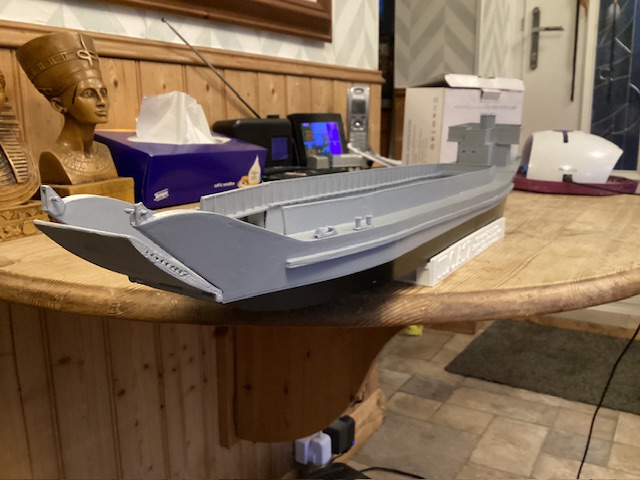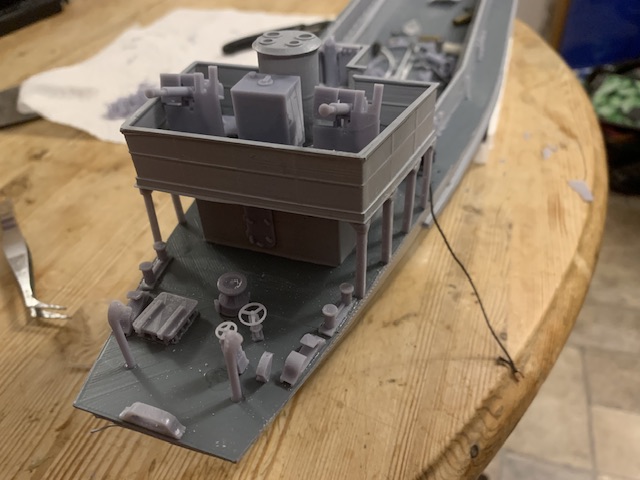Cockpit done on the P-40
Might add a little bit of pigments or wash to the seat belts to dirty them up some, but pretty happy overall
Cockpit done on the P-40
Might add a little bit of pigments or wash to the seat belts to dirty them up some, but pretty happy overall
Hey, hey. Coming aboard with a Tamiya Sd. kfz. 232 armored radio car.
Still reading about scout units, panzer divisions, unit organization, Afrika Corps, and stuff so not starting just yet. Hoping to build a series of models belonging to the same Section/Platoon/Company/Battalion at the same place at the same point in time. May build a vehicle used in Afrika. May build a vehicle used in Russia. If the project goes to plan, this will be paired with a Sd. kfz. 223 (The Great Ones campaign), resulting in a complete radio car section of a signals platoon of a recon company of a scout battalion. Not sure if I have that all correct. Still learning.
Interesting. Have to admit I do like the look of those big 8 wheel armoured cars. Looking forward to seeing it come together.
Right, so test fitted the pilot today and he doesn’t fit. Not without amputating his feet. Should’ve tested that before I painted him. Lesson learned.
Plan B. Make some seat straps and keep him to one side for the inflight dogfight double kit.
Hi Everyone,
There are certainly some varied and interesting builds going on here! They look great. Keep it up!
After completing a couple of projects, I’ve been able to focus a bit more on the TBD. Following an inspection, and few mock-up fits, and notes on the instructions, I confidently started to put glue to plastic!
One thing that I noticed right off is that the foot holds on the fuselage are just holes through the fuselage. On the real thing these foot holes were covered with a spring flap, such that when you put your foot onto the foot hold, the flap would flip in, allowing your boot to fit into the hold, and when you moved onto the next hold, the spring would flip the flap back to the original position.
I remedied this error on the kit by taking some 0.20 stock styrene and shaped it to fit into the holes and glued them into place in such a way as to not lose the outline of the foot hold.
Following the instructions, construction began of course with the cockpit. The detail here is quite nice, and far more detailed that the aged Monogram kit. One thing that I noticed right off the bat was that the plastic is bit on the brittle side and very prone to breaking by just looking at the part. Taking care in part removal didn’t seem to matter. This would certainly become a consistent point of frustration for me. I muddled through and was able to get the basic cockpit area constructed, and then moved forward with a base coat of black primer (MS1500 Black).
Moving forward, the cockpit area was glued together, and the primer was covered with a mix of interior green. Once dry, various areas were given some black, red, and silver dry brushing to bring out some detail, and Tamiya brown wash to add depth.
I was a bit unsure of whether there were shoulder straps at this time. While it is known that the F4F-4 saw shoulder straps used for the first time during the Midway battle, I couldn’t really find anything definitive regarding the Devastator. So, I opted to go without. Saving the kit’s nice PE belts, in exchange for a set of whiteish IJN belts. The result was pretty convincing.
GWH decided to use decals for the instruments in the instrument panel, and were kind enough to provide two sets, just in case! These went on with no problems, and following the instructions, all decals were placed and set with Mr. Softener. I felt things were a little bland, so I did add some placard decals from the decal dungeon. After the decals were dry, they were sealed with Future floor wax, and then a little dry brushing, using some silver, and then a dull coat, followed by highlighting the glass covers of the instruments using Future floor wax once again. I like how it turned out.
While all of the above was going there were numerous dry/test fits of the cockpit into the fuselage made. Given the fiddlyness of the instrument panel I didn’t test fit it, and boy was that a whoopsie doodle on my part! Needless to say I got the fuselage closed up, although the instrument panel would not fit correctly into its slot. After an hour of messing around with the fit, I simply glued the two instrument panels together and fit them in front of the firewall. While not perfect, it is hard to notice. Sigh. One thing I did do while dry fitting the parts was to notice that none of the nice PE for the bombardier area would not be seen when completed, so I left it off.
Now it’s onto the getting the airframe constructed! Till next time, be safe, wash your hands with soap and water, and have lots of fun!
LCT1 back again, I thought I was running into trouble with this after it got knocked off its shelf and partially broke the bow off. Glued back on, bit of filler and you wouldn’t know. Bottom masked and painted, first bits printed and dry fitted



Very impressive Andrew. Look forward to seeing it make a landing!
And all fitted in the fuselage.
The fit is quite tight and some paint needed to be scraped away to get a good fit of the cockpit into the fuselage.
An elastic band was still needed to pull the nose together and close a gap.
Looks fantastic, Michael. I am not stopping you! ![]() I always wanted to see one of these 1/350 kits build. So far I have resisted the temptation to buy one.
I always wanted to see one of these 1/350 kits build. So far I have resisted the temptation to buy one.
Looking forward to seeing more ![]()
Don’t get your hopes up too far. I’m no ship builder and I’m approaching this one very carefully. I’m a huge Enterprise fan and don’t want to screw it up. Adding the degaussing cables already took some time and learning curve. The kit came with them as photo-etch, but not only are they flat and look wrong, but they in no way fit the way the real ones did. So I got some Plastruct .015 rod and took the plunge. What next? Still trying to plan that out.
Michael ![]()
![]()
Tamiya Sd. kfz. 232 Armored Radio Car
Hocus pocus…presto chango… Construction is almost done. As a kid, this model was fairly high on my want list. Now it is a canvas for painting practice. The current plan is to make a vehicle belonging to 10, 15, or 21 Panzer Division in 1942, probably in Africa.
I have patience, Michael ![]() Take your time on a big and complex build like this. I am sure it will look stunning when finished.
Take your time on a big and complex build like this. I am sure it will look stunning when finished.
Doug, nothing like a blast from the past. I am almost finished with the Tamiya as.kfz. 7 with 37mm flak. Such a nice build despite the crude details and very basic rubber tracks.
Looking forward to see what you get from your Tamiya kit.
Nope Michael, not gonna stop you, after all you’re in too deep!
LCT 17 starting to get deep into fitting out. Prop shafts are ordered, meanwhile starting to add all the little bits that make a ship model

The four stanchions under the bridge wings are distinctive on the first three series of LCT. The crowded quarterdeck is also a feature.

Ballast flooding pipes and gooseneck vents to allow off centre loads to be equalised.

The quarterdeck, the anchor platform is absent from these and I need to check what anchor handling gear is needed.

A17 with my part finished LCG 19, a conversion from LCT(3) type shown as she was in late 1944.
Great detailing. Looks very nice …
Tamiya Sd. kfz. 232 Armored Radio Car
Model is built up. May add a few more details before washing and painting. Not sure what to do about stowage. Still undecided on markings.
Progress has been made with the SM79, not exactly fast but not slowly either LOL. So most of the weathering is done I just have to add the waist guns and unmask it. So I should be finished soon enough.
 IMG_2354 by Chris Wilson, on Flickr
IMG_2354 by Chris Wilson, on Flickr
 IMG_2355 by Chris Wilson, on Flickr
IMG_2355 by Chris Wilson, on Flickr
 IMG_2356 by Chris Wilson, on Flickr
IMG_2356 by Chris Wilson, on Flickr
 IMG_2357 by Chris Wilson, on Flickr
IMG_2357 by Chris Wilson, on Flickr
 IMG_2358 by Chris Wilson, on Flickr
IMG_2358 by Chris Wilson, on Flickr
 IMG_2359 by Chris Wilson, on Flickr
IMG_2359 by Chris Wilson, on Flickr
Really nice job on the camo! Nice to see an unusual subject being tackled